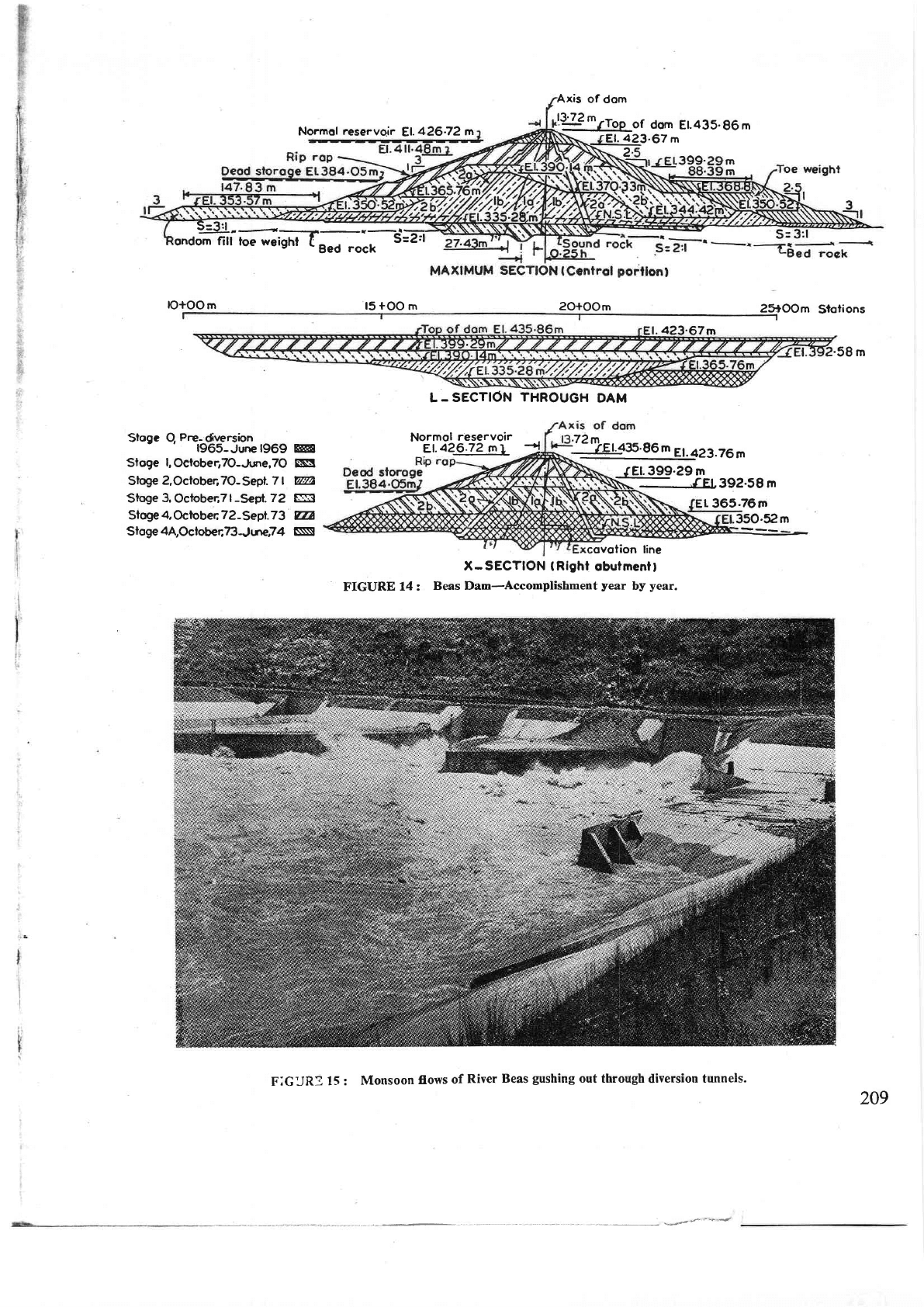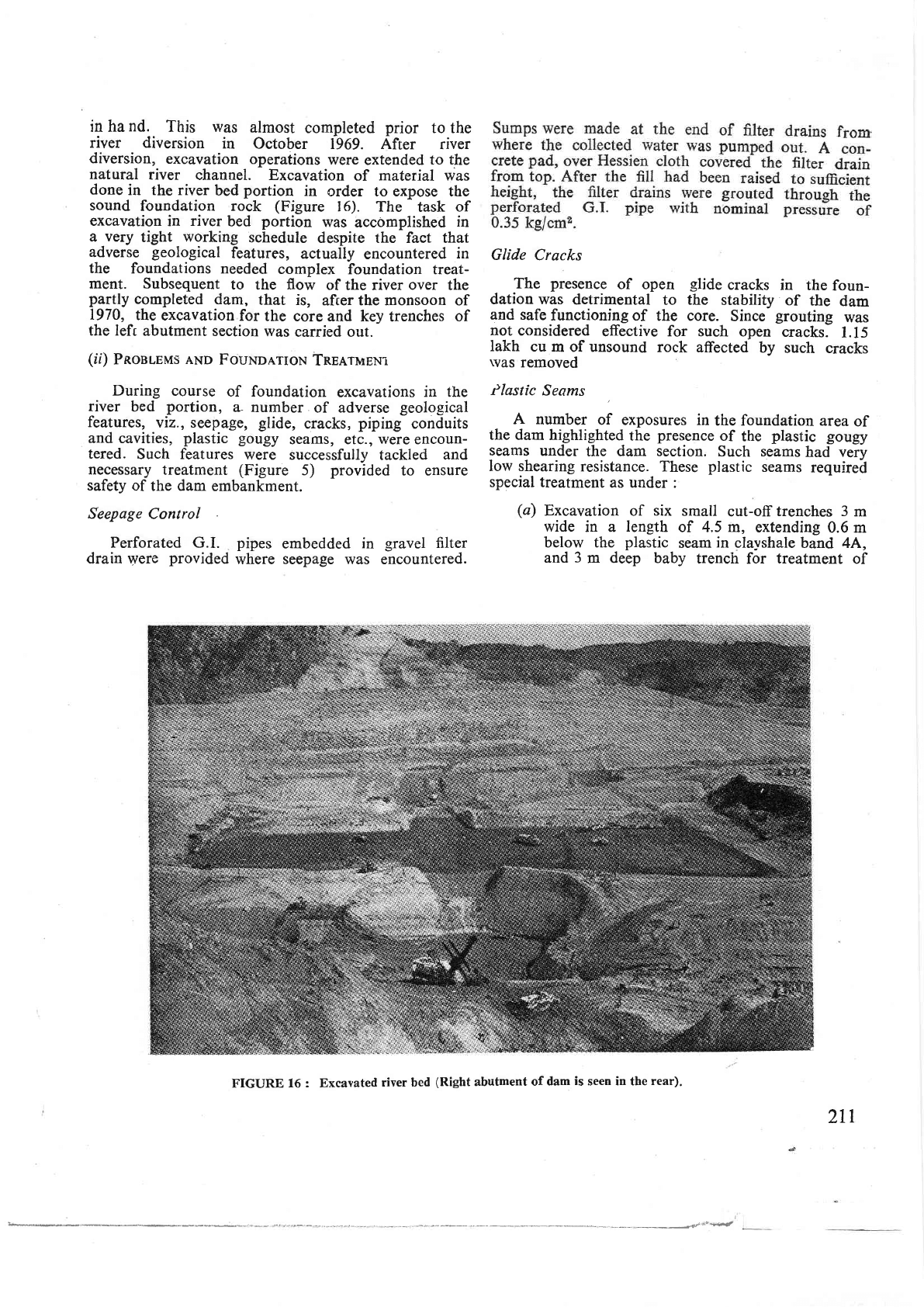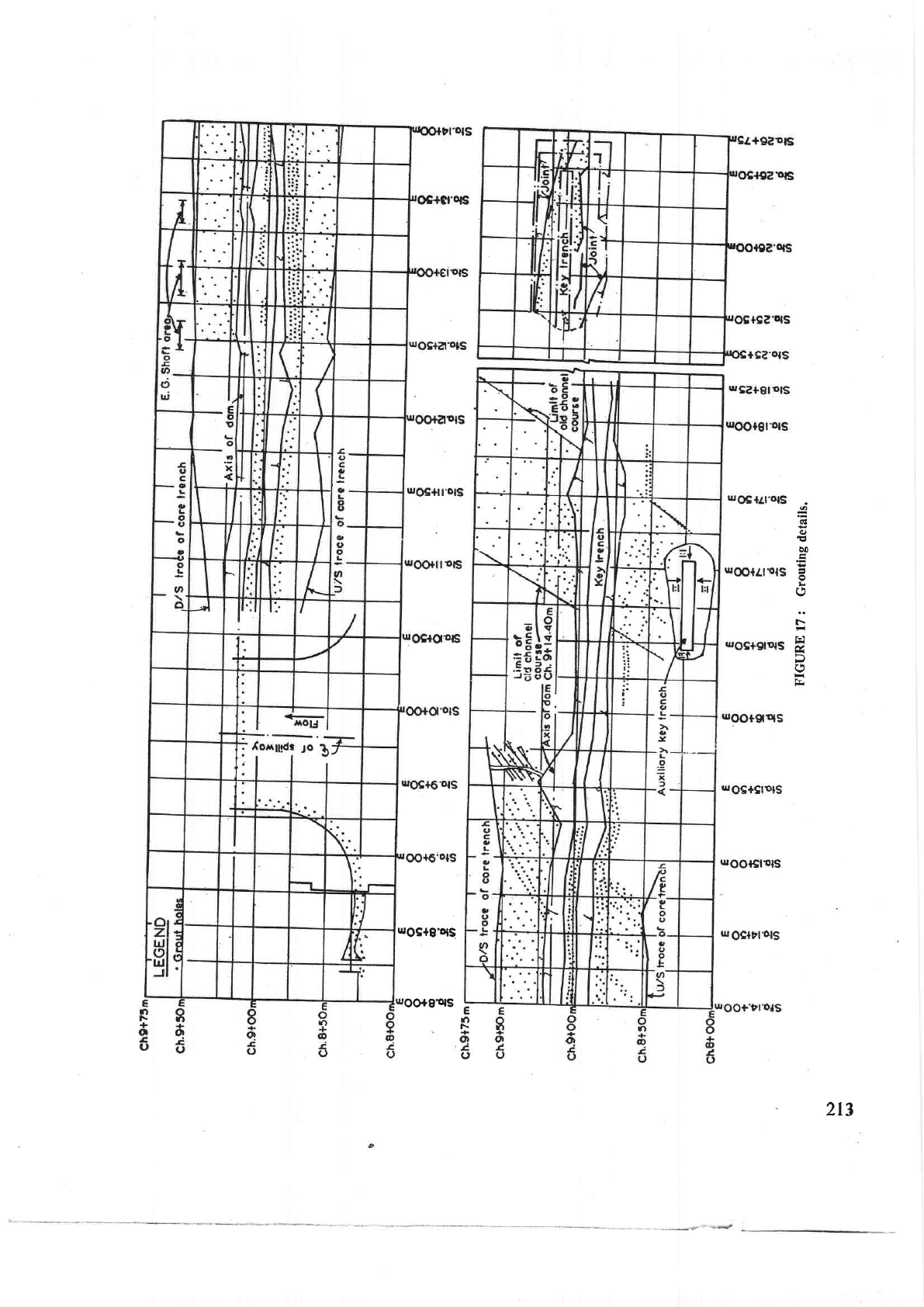Indian National Committee on Large Dams. Design and Construction Features of Selected Dams in India
Подождите немного. Документ загружается.


Stages
Period
Monsoon
river
discharge
flowing
through
Progress
of
fill
placement
of
dam
Stage-0
Stage-I
Stage-Il
Stage-III
Stage-IV
Stage-IVA
October
October.
October
October
1970-June
1971
l97l-June
1972
1972-lune
1973
I973-June
1974
1965-June
1969
October
1969-June
l97O
Natural
river
bed
Tl,T2,Pl,
P2
& P3
and
over
partly
com-
pleted
dam
Tl,
T2, Pl,
P2 &
P3
Tl,
T2, Pl, P2
&
P3R
Pt,P2
&
P3R
P3R
and Spillway
\igh_t
abutment
raised
up
to Et. 365.76
m
simultaneously
with
constiuction
of
iunnits"
Right
abutment
up
to
El.
3g2.Sg
m
and
central
portion
up
to
El.
335.2g
m.
Central.
portion
up
to El.
390.14
m
(trunca-
ted
section).
Central
portion,
right
and
left
abutments
(truncated
section)
up
to
EL.399.29
m.
Central
porrion,
right
and left
abutments
truncated
section
up
to
El.
423.67
m.
Dam
substantially
completed
up
to
El.
435.86
m.
Bulk heod
Progress
>
Excovotion
line
IIITIIIITLrIT
Scnedd
guide
trus
Sli,ck
p,p"
for
invert
pour
?
50 m
working
room
L-SECTION
SHOWING
GENERAL
Overt
forrn
ARRAN6EI,ENT
Riser
Side form
Screed
trusses
PL
AN
208
FIGURE 13:
Tunnel
concreting-General
set-up.

Axi5
qf
66m
Normof
neservoir
il.
426.72
m
!93mrrop
of
dom
8t.435.96m
El.423.67 rn
2
399. m
m
-
q.-2.r
9-t
onoonr ntiroe weistrn
Tfr']'Ei
IOtOO
m
15 fOO
m
2OtOOm
2$OOm
Stolions
@23.76m
f
El.399.29 m
sE--fEt392.58m
covotion
line
X-SECTION
I
Rlght
obutmentl
FIGURE
14:
Beas Dam-Accomplishment
year
by
year.
FlGiJR3
15 :
Monsoon
flows
of
River
Beas
gushing
out through
iliversion
tunnels.
n'
4*'-+'4
t
365.76m
35O.52m
'58
m
l.423.67m
L
-
SECTION
THROUGH
DAM
Stogc O.
Pre-
dversion
1965-June
1969
Stoge
l,
OcloberrTO-.lne,7O
Stoge
2,OctobecTO-Sept 7 |
Stoge
3,
OctobecT
|
-Segt.72
Sloge
4,
Octobec
72-Sept
73
Slog
ArOclobecT3
J
rurr-7
4
Normol
reservoir
E,1.426',.72
n!_
a
EE
ssl
wvz,
Fslir
w
ts\\l
209

I
r
t
I
tunnels were
closed
in stages, after
these
had
served
the
diversion
requirements.
The
tunnel P3 was closed
for
second
stage
works, that
is, completion
of bulkhead
reach and
installation
of emergency
gate
in
October
1971. This tunne!
was re-opened
as
gated
tunnel
in
June
1972
for
passing
river
flows. Tbe
river bed
entries
of the
T-tunnels and
P-tunnels
(Pl
and P2 only),
were
closed
by
lowering stoplogs
in
the
upstream
portals
during September
1972
and October
1973
respectively
for
taking up
permanent
closure
plugs
and
second
stage
works. The
final
closure of P3R tunnel
for
conversion
into
penstock
was
planned
by
lowering
gate
through
bulkhead shaft with the
reservoir level at
El. 384.05
m. For
this
purpose,
a lined
construction
of
size
3.05
m
x6.40
m was constructed
in
the
tunnel.
However, during
operation
of
the
restricted
P3R
tunnel,
the
liners
provided
in the
bulkhead
reach
got
ripped
off
due
to high
velocity flows. It was,
thus
not
possible
to
block
the river bed
entry
of P3R
tunnels,
as
originally
planned.
The
final closure
of
P3R tunnel
was,
therefore, affected
by
lowering
stoplogs
in
the
upstream
portal
under
53.3
m deep
water with
the
help
of
divers and
derrick crane
in June
L976.
Lowering
of
stoplogs under
53.3
m
deep
water
was
an unprecedented
job
and
was
accomplished
by
meticulous
planning
and
devising facilities
necessary
for
successful
closure
of the
tunnel.
2. CONSTRUCTION OF DAM
The
construction of
dam involved
the
placement
of
nearly
35 million
cu
m
of
fill
materials
and about
nine
million cu m of excavation of
river
bed meterial
and
rock.
Tbis
was
a
stupendous
task
and required
thorough
pre-planning
of all operations, including
selection of equipment, facilities
to keep
the equip-
ment
in
good
working older,
arrangement
of spares,
tyres, fuels,
lubricating
oils, etc.
Section
of
Dam
Section
of the
dam and its
zoning
was
designed
to
facilitate
the
maximum
use of the materials
avai-
Iable
from excavation
of
various
appurtenant
works,
yfu.,
spillway,
tunnels,
approach
channels,
stilling
basins,
etc.,
for impervious core and
natural
river bed
deposits
for
filter
and
pervious
zones.
The final
maximum
section of
the
Beas
Dam
with
zoning
arrangements
as adopted,
is
given
in
Figure
6.
The
main
embankment of
the
dam
was
divided
into the
following
fill
zones
(f)
Iurnnvrous
Zolre
This
zone
comprised earth from stockpiles
of
materials
excavated
from
various
structures or
directly
from
excavation
of
foundations.
la-The
material
for
this
zone
was
primarily
the
clay
shale
containing
less
than
50
percent
sand
rock.
210
Ib-The
material
for
this
zone
was
primarily
the
sand
ro-ck
containing
less
than
-50
percent
clay
shale.
core.
(ff)
Prnvrous
ZoNr
This
zone
included
2a-Filter
zone
of selected
free
draining sand
and
gravel
wifh
not more
than l0
percent
of size
l.a-rger
than
75
ffiD,
but material
exceeding
150
mm
was
not
permitted.
2b..
Pervious
zone
of
selected
free
draining sand,
gravel,
cobbles
and
boulders. The
maximum
size
of
the
material
used
was
such that
no
stone
protruded
above
the
compacted
lift
of
0.6 m.
Rip-rap
of selected
gravel,
cobbles
and
boulders.
Upstream
and downstream
toe
weights of
random
material.
Excavation
and
Treatment
of Foundation
(i)
ExcevArloN
About
nine
million
cu
m
of excavation of river
bed
material
and
rock
was
involved
for foundations
of
the
dam.
In
the
river
portion
under the shell
zone
of the dam
embankment,
the
excavation
was extended
to
clean
sand;
gravel
and
cobble material having
same
characteristics
as
that
of
shell zone material. Tbe
excavation of
core
trench
on right
abutment
was
taken
up to
a
minimum
depth
of
6
m
below the
actual
bed
rock level
or to
the sound rock
level
whichever
was
lower.
However,
this criteria
was
dispensed
with
as
it was
considered
that no useful
purpose
was
served
by
excavating
the
sound
rock
first
and
then replacing
it
with the
same
material.
In
the
river
bed
portion,
the core
ftench
excavation
was, therefore,
extended
to sound
bed rock
only. The
key
trench was,
however,
excavated
6 m below
the
bottom of the
core
trench.
The
excavation
work
commenced
in
October
1965,
when the
excavation
on the right
abutment
was
taken

in ha
nd.
This was
almost
completed
prior
to the
river diversion
in
October
1969. Afrer
river
diversion,
excavation
operations
were
extended
to the
natural
river
channel. Excavation
of material was
done
in the river
bed
portion
in
order to expose the
sound
foundation rock
(Figure
16).
The
task
of
excavation
in
river
bed
portion
was
accomplished
in
a
very
tight
working
schedule
despite the fact that
adverse
geological
features,
actually
encountered
in
the
foundations needed
complex
foundation treat-
ment. Subsequent
to the flow
of the river
over
the
partly
completed
dam,
that
is,
afier
the monsoon
of
1970,
the
excavation
for
the
core and key
trenches
of
the lefi
abutment
section
was
carried out.
(fi)
PaonLEMS
nNo
FouNDArroN
TnrerueNr
During
course
of foundation
excavations
in the
river
bed
portion,
a
number
of adverse
geolo-eical
features,
viz., seepage,
glide,
cracks,
piping
conduits
and cavities,
plastic gougy
seams, etc.,
were
encoun-
tered.
Such features
were
successfully
tackled
and
necessary
treatment
(Figure
5)
provided
to ensure
safety
of
the
dam
embankment.
Seepage
Control
Perforated G.I.
pipes
embedded
in
gravel
filter
drain
Were
provided
where
seepage
was encountered.
Glide
Cracks
The
presence
of open
glide
cracks
in
the
foun-
dation was
detrimental
to the
stability
of
the
dam
and safe
functioniqg of
the core.
Since
grouting
was
not
considered
effeltive for such
open
-cracks]
t.tS
lakh
cu
m of unsound
rock
affected
by
such
cracks
rvas
removed
flastic
Seams
A
number
of
exposures in
the foundation
area
of
the dam
highlighted
the
presence
of
the
plastic
gougy
seams
under
the
dam section.
Such seams
had very
low shearing
resistance.
These
plastic
seams
required
special treatment
as under
:
(a)
Excavation
of
six
small
cut-off
trenches 3
m
wide
in a
length
of 4.5 m,
extending
0.6 m
below the
plastic
seam
in
clayshale
band 44,
and
3
m deep baby
trench
for
treatment
of
FIGURE
16 : Excavated
river bed
(Right
abutment
of
dam
is
seen in the
rear).
2lr

plptlc
seam
at
the base
of
clayshale
band
8A. The
trenches
cut
the
plastic
seams
and
provide
a longer path
of
percolation.
(b)
Placement
of
upstream
and
downstream
toe
wgielts
.-requiring
additional
fill
placement
,
of 2.8 million
cu
m.
This
additional
dll
became
necessary
for
safety
of
the
dam
under
seismic
condition
in
view
of low
shearing
strength of
gougy
seams.
(c)
lxcgvation
and
concreting
of
eight rigid
buried
shafts
3 m
diameter
and 2t.l
m
aeef
at bench
elevation374.9
m
for safety
of
hilislope near
penstock
intake
shafts.
Piping
Conduits
In
the key
tretch
excavation,
active
seeoage was
obscrved
in sand
rock band No.
2
through
i iumber
3. DAM
EMBANXMENI
of
openings-
As
excavation
for
key
trench-progressed,
a
nu4be1
o{
piping
conduits and
cavitiei wire
also
FiIl
Materials
trouced
on
rts
downstrcam
side. The
followins
measures
wcre adopted
to
reduce
thc
prospect
of
eas-y irosion of
The
quantity
of fill
materials
utilized
for the
sand rock
and of seepage
inlhe
itam
found'ation:
constroctii;
"fit
"
aa--i*!.-riii"r-i"
(a)
Extension
of
k€v trench
between
stations
Impervious
core
zone
(fc
and 16)
10-97 nillion
cu
m
17*37.3 m
to 17
+52.6
m
so as to cross sand -.-''.''
rockband
No.2 and
an
auxiliary
key
trench,
trltet
zone
2a
1.67
rrillion
cu m
5.5
g
long,.
gltenping
one metre
ieep Loto-"tgy-
pervious
zone
2J
22.40
million
cu m
shale
band No.
3.
The
excavared
deDth of this
auxiliary
key
trench varied
from
7.6 m to
Selection
of Material
10.7
m.
GroutinglPrbcedure
(b)
Drilling
of
25
drainage
wells,
300
mm diameter
and
25
to
77.2
m deep
filled
with
sand and
gravel
at the toe of
impervious
core.
In the
river bed
portion,
area
grouting
was
done
at 6 m
spacing, within
30
m, on either
side
of the
key
trench
and cover the
old
perennial
channel
section so
as to
seal
off the
cavities
in
sand rock
band No.
2.
Area
grouting
at
6 m
spacing was
extended
over
the
done
in
order
to cover
the
possible
extension
of
the
cavities
in sand
rock
band
No.
2.
The
area
grouting
under
gravity
head
was further
extended
on
the left
abutment,
under
the
core trench
212
IMpsnvrous
MATERIAL
In
the
meanwhile,
excavation
for
diversion
tunnels
and construction
of approach
roads
had
started.
It
was
observed
that
the
excavated
material
crumbled
down
into
-fine
earth
in
the
process
of blasting
and
subsequent
dozing.
This
material
was
tested
and
found
ideal
for
use
in
impervious
core.
The
test
results
are
summarized
below
:
(t)
The material
was,
generally,
finer
than
2 mm.
(tt)
The
_
material
was
easily
compactible
and
provided
-on
average
density
of- 1.94 gmlcc
with
specific
gravity
of 2.69.

t7
ct
q)
t
00
f-
r-1
D
wos+8'ots
oo+8!ts
213

khod
orto
Av
E1.338.32n
Sibo khod
Av.81.381.6
m
c
20o
f
L
a?1
O
!v
?
o
o
60:
c
o
(t
80b
(L
o
I
6
4
c
o
E
L
o
.g
b
c
o
(,
L
o
(L
A,8,C,D,E.F,G
ond
H
llnpervbut
cora
lo
&
lbl
Solhono,
GojrKhonpur.
Sibo.
Lr.
M.N,
pond
O
t Filtcr
ond
pervi'6ui
Zo
&
Zb
t
Eorrow
or?og
oo
9s
(ii)
Unit
submerged
weight
(iii)
Unit
saturated weight
(iv)
Coefficient
of
permeability
(v)
Angle
of
internal friction
(vi)
Cohesion
o
I
o
666
o@
Size
in
millimelre
s
LIMITING GRADING CURVES
FIGURE 18.
q90
no
r}rlFo
o
(iii)
The
permeability was of the
order
of
l0-?
cm/sec
(lv)
Average value
of
cohfsion was
0.4
kg/cm2
(u)
Pore
pressures
were almost
negligible.
On
the
basis of
the test
results, the
soil
charac-
teristics assumed
for the
impervious
material
were
:
(i)
Unit
moist
weight
214
l.l6
gm/cc
2.16
gmlcc'
10-G
cm/sec
or less
26.5
degrees
0.35
kg/cmz
BORROW
AREAS
2.08
gn/cc

FnrsR Mlrentnr,
In the
initial stages,
the
placement
was
started
from
SiUa
fnaO,
a rjvulet
about
5
km
upstream
of
the
dam
axis.
The
material
contained
small
percen-
Penvlous
Ma.remA.r
action.
on
the
basis
of
extensive
field
and
laboratory
tests'
tne
fodowing
design
parameters
for
the
pervious
material
were
evolved
:
could serve
as
a
natural
passage.
The
local depres-
sions
were
filled
up
manually
with
'la'
material
and
compacted
with
pneumatic
tempers. The
foundation
surface
was
moistened
to
obtain a suitable
bond
with
the embankment.
Conn
Tnsxcn
After
the
key
trench
had been
filled, the
work
of
filI
placement
was
extended
to
the core
trench.
Since
the
working
area had
widened,
operations
were
divided
into
different
lanes of about
30
m
width each
parallel
to the
axis
of
dam
so
that entire
operations,
viz.,
dumping
the
fill
material,
levelling,
stone
picking
and
compaciion
could
be carried
out
in
a
continuous
cycle.
Pl,nceueNr
rN
LnYgRs
tyred
equipment
which
crossed
the
fill
embankment
for
dunipiirg
operations,
the surface
of
the
previous
layer
was siarified
before
the
placement
of
the
next
layer.
Morsrune
CoNlnNr
Coupe,crtoN
(i)
Unit
moist
weight
(r'i)
Unit
submerged
weight
(iri)
Unit
saturated
weight
(iu) Angle
of
internal
friction
38
degrees
(v)
Cohesion
Nil
(vi)
Perme
abilitY
1 x
l0-4
cm/sec
The
limits
of
grading
curves
for
fill-materials,
are
shown
in
Figure
18.
4. FILL
PLACEMENT
Impervious
Core
Zone
Kev
TnetIcH
The
final
cleaning
of
the
surface
was
done
by
.ru^-
o?
uit
jets
so
as
to
remove
sand
content
which
L.92
gmlcc
1.20
gm/cc
2.20
gmlcc
215

rock
was
carried
out
by means
of
pneumatic
compactors.
Figure
l9
depicts
various
operations
of impervious
€ore
construction,-viz.,
material
production,
fill
place-
ment
and
compaction.
Filter
Zone
(2a)
PraceueNT
AND
Morsrune
CoNrenr
During
the
initial stages,
the
placement
was
carried
out
in
0.6 m
thick
layers and
equal
amount
of water
workable
moisture
content. The
placement
was
done
in
two lifts,
each
of
0.3
m.
Each
of the
two litts
yls sufficiently
watered
prior
to
the rolling
of
total
trift
of
0.6 m.
CoupecuoN
The
compaction was
done
with
5 and
l0 tonnes
vibratory
compactors. For
proper
compaction,
four
coverages with
5
tonnes
and
two
coverages with
10
tonnes
compactors
were
given.
Prior
to
receipt
of
vibratory
compactors on
the
project,
the
compaction
of
0.3 m thick layers
was done with D-9
crawler
tractor.
Sixteen
coverages were
given
to
ensure com-
paction
of
the material.
The
material was
originalty
compacted
to
achieve
a minimum
relative
density of 80
percent.
The
corres-
ponding
values
obtained
for
dry
density of
the
material
ranged
between
2.16 to 2.40
gmlcc
against the design
value
of
1.92
gm/cc.
This
indicated that the
material
was being
over
compacted,
thereby decreasing
the
permeability
of the
material.
The
specified criteria
for
compaction
of the
filter
material
was
revised
to
70
per-
cent
and
this was
followed up to
the end
of
1968,
when
it
was revealed
that
the
relative
density tests
perfor-
med
yielded
inconsistent results.
In some
of
the
tests
for
the
same fill,
density was
of
the order
of 2.16
gm/cc.
The
relative
density,
varied
from
32 to
86
percent.
2t6
fhe
.compaction
criterion
was
modified
from
rerative
l.::ril^"l
/u
percent
to
a
minimum
fill
dry
density
of
z
gmlcc.
Pervious
Shell
Zone
(2b)
Preceugxr
MorsruRp
CoNreNr
coverages
required
to
attain
the
requisite
relative
density
varied
between
6
and
22.lt
w'as
thus
establi-
shed
that
the
addition
of
water
did
not appreciably
affect the
density
results.
As
such,
the
addition
oi
water
on
pervious
fill rvas
abandoned.
CoupacrroN
With
the
dry
compaction
of fill
material,
the
specified density
results
were
achieved
with
four
passes
of
a
S-tonne
compactor.
The
number
of coverages
was
two, when
a l0-tonne
compactor
was
deployed.
-

a
@
o
L
O)
o
L
o-
.5
c
.9
o
o
o-
E
o
o
E
C
o
C
o
E
o
(J
o
o-
=
ir
3o(
-E
rYl
t4
D
rh
v
H
I
?o
;=
-o
c,
o
(JL
oL
;o
rJ
Lcr
.o*
o
^-o
=o
h3
;Tl
:o
\J
*or
vt
r-
C
oq)
L!
+-
q)
.9q
tJ
6;
{-.-
oo
6
I
o
o
U
X
o)
q,
L
B
q)
o
C
o
o
E
L
€
i(
()
o
(-
(-
o
Q)
()
C
o
L
o
o)
O-g
o-O
{=
o
o
L
o
+
(]
E
E
e
o
o
T
(F
o
o
u
C
o
L
o
o)
o_
o
_o
2t7
L-
